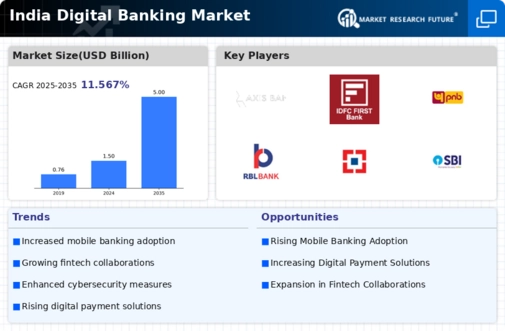Shift in Consumer Behavior
There is a noticeable shift in consumer behavior towards digital banking solutions in India. Younger generations, particularly millennials and Gen Z, prefer the convenience of online banking over traditional methods. This demographic is more inclined to use digital wallets and mobile banking apps for their financial transactions. Recent surveys indicate that 65% of consumers aged 18-34 have adopted digital banking services. This shift is reshaping the digital banking market, as financial institutions adapt their offerings to meet the evolving preferences of tech-savvy customers.
Growing Smartphone Penetration
The proliferation of smartphones in India is a key driver of the digital banking market. With over 700 million smartphone users, the accessibility of banking services has significantly improved. This trend is further supported by affordable data plans, which have made internet access more widespread. As a result, mobile banking applications are witnessing increased downloads, with a reported growth of 40% in user engagement over the past year. This surge in smartphone usage is likely to continue driving the digital banking market, as more consumers opt for convenient banking solutions.
Increased Investment in Fintech
The digital banking market in India is witnessing a surge in investment in fintech startups. These companies are innovating and providing niche solutions that cater to specific customer needs, such as peer-to-peer lending and robo-advisory services. In 2025, investments in fintech are projected to reach $10 billion, reflecting a growing interest from venture capitalists and private equity firms. This influx of capital is likely to foster innovation and competition within the digital banking market, ultimately benefiting consumers through enhanced services and lower costs.
Regulatory Support and Initiatives
The Indian government has been actively promoting the digital banking market through various regulatory measures and initiatives. The introduction of the Digital India program aims to increase digital literacy and promote cashless transactions. Additionally, the Reserve Bank of India has implemented guidelines to enhance the security and efficiency of digital transactions. These regulatory frameworks are expected to boost consumer confidence, leading to a projected growth of 25% in digital banking transactions by 2026. Such supportive measures create a conducive environment for the expansion of the digital banking market.
Technological Advancements in Banking
The digital banking market in India is experiencing a surge due to rapid technological advancements. Innovations such as artificial intelligence, machine learning, and blockchain are transforming traditional banking operations. These technologies enhance customer experience by providing personalized services and improving operational efficiency. For instance, the integration of AI in customer service has led to a 30% reduction in response time for queries. Furthermore, the adoption of blockchain technology is expected to streamline transactions, reducing costs by up to 20%. As a result, banks are increasingly investing in these technologies to remain competitive in the digital banking market.























Leave a Comment